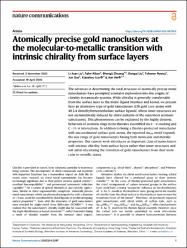Atomically precise gold nanoclusters at the molecular-to-metallic transition with intrinsic chirality from surface layers

Göster/
Erişim
info:eu-repo/semantics/openAccessTarih
2023Yazar
Liu, Li-JuanAlkan, Fahri
Zhuang, Shengli
Liu, Dongyi
Nawaz, Tehseen
Guo, Jun
Luo, Xiaozhou
He, Jian
Üst veri
Tüm öğe kaydını gösterÖzet
Chiral metal nanoclusters prepared from achiral ligands generally contain chiral kernel structures. Here, the authors report an alternative type of gold nanoclusters whose intrinsic chirality arises solely from the arrangement of the organic components on their surface.
The advances in determining the total structure of atomically precise metal nanoclusters have prompted extensive exploration into the origins of chirality in nanoscale systems. While chirality is generally transferrable from the surface layer to the metal-ligand interface and kernel, we present here an alternative type of gold nanoclusters (138 gold core atoms with 48 2,4-dimethylbenzenethiolate surface ligands) whose inner structures are not asymmetrically induced by chiral patterns of the outermost aromatic substituents. This phenomenon can be explained by the highly dynamic behaviors of aromatic rings in the thiolates assembled via pi - pi stacking and C - H center dot center dot center dot pi interactions. In addition to being a thiolate-protected nanocluster with uncoordinated surface gold atoms, the reported Au-138 motif expands the size range of gold nanoclusters having both molecular and metallic properties. Our current work introduces an important class of nanoclusters with intrinsic chirality from surface layers rather than inner structures and will aid in elucidating the transition of gold nanoclusters from their molecular to metallic states.

















